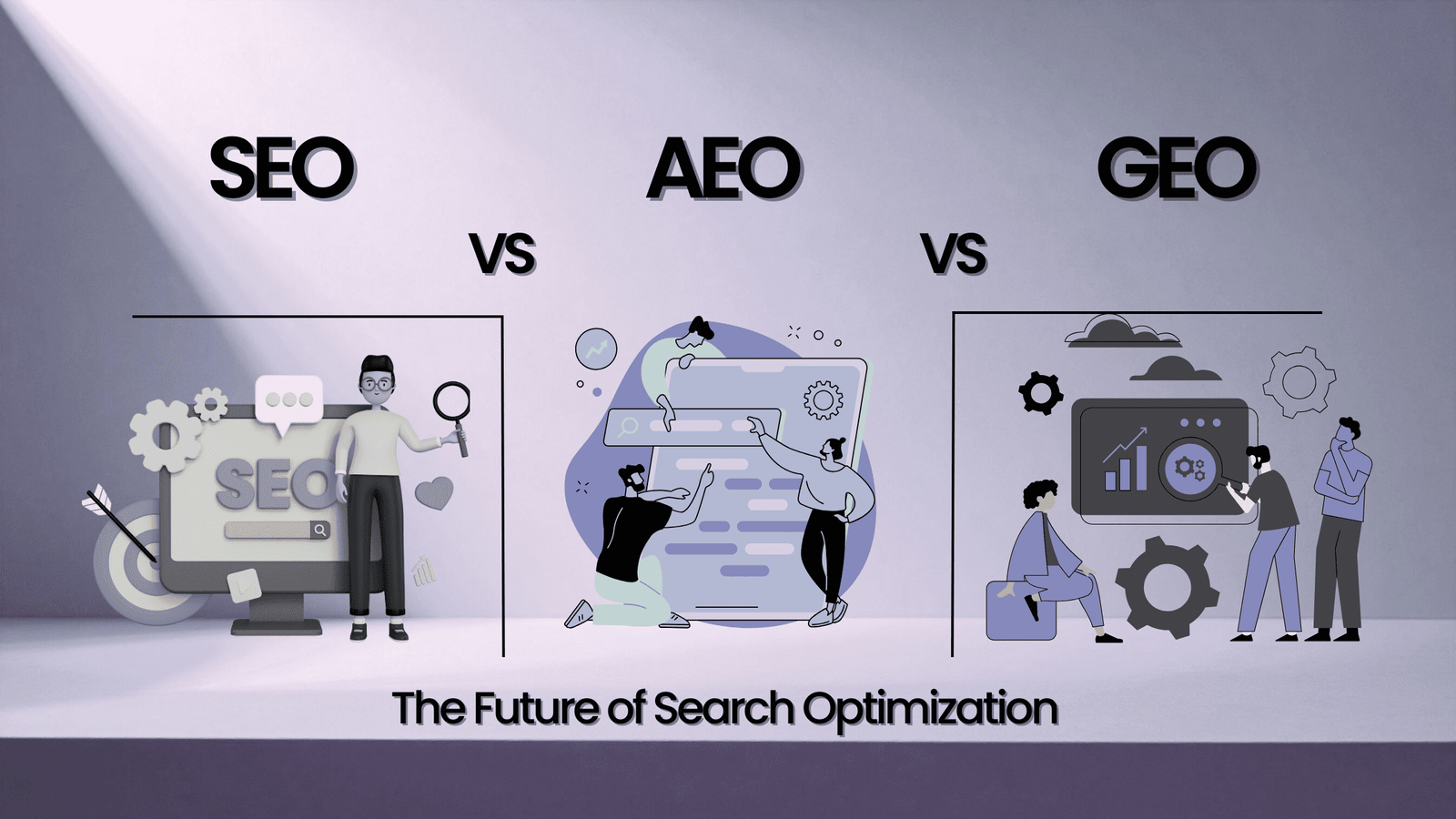Introduction
In today’s digital world, being visible on search engines is no longer optional—it’s essential. But as search evolves, the strategies that worked five years ago no longer guarantee results. Modern search optimization isn’t just about keywords; it’s about understanding user intent, providing answers, and connecting with audiences locally.
Enter SEO (Search Engine Optimization), AEO (Answer Engine Optimization), and GEO (Geolocation Optimization)—three approaches that shape how content reaches users. In this guide, we’ll explore each, compare them, examine the latest trends, and provide actionable insights backed by Google updates and best practices.
1. SEO – The Foundation of Search
What is SEO?
SEO, or Search Engine Optimization, is the process of improving a website’s visibility on search engines like Google, Bing, and Yahoo. It ensures that your content appears in search results when users look for information, products, or services relevant to your business.
Key Components of SEO
- On-Page SEO: Optimizing individual pages for keywords, meta tags, headings, and content structure.
- Off-Page SEO: Building authority through backlinks, social shares, and brand mentions.
- Technical SEO: Ensuring site speed, mobile-friendliness, structured data, and crawlability.
How SEO Works in 2025
Google’s algorithms are evolving rapidly. In 2023 and 2024, updates like Google Helpful Content Update and Core Web Vitals emphasis highlight the importance of:
- Content quality and relevance
- User experience (UX) and site performance
- Search intent alignment
Reference: Google Search Central: Core Web Vitals
Latest SEO Trends
- AI-Powered Content: Google’s MUM (Multitask Unified Model) can understand complex queries and deliver nuanced answers.
- Voice Search Optimization: With devices like Google Nest and Alexa, users ask questions conversationally.
- Featured Snippets & Rich Results: Structured data and schema markup help content appear at the top of SERPs.
2. AEO – Optimizing for Answers
What is AEO?
AEO, or Answer Engine Optimization, focuses on optimizing content to directly answer user queries rather than just ranking for keywords. Unlike traditional SEO, which aims to rank for general queries, AEO ensures your content appears in featured snippets, people also ask boxes, or AI-powered answers.
How AEO Differs from SEO
| SEO | AEO |
| Focuses on keyword ranking | Focuses on answering specific questions |
| Optimizes pages for visibility | Optimizes snippets for instant answers |
| Traditional link-building | Emphasizes structured data and conversational content |
Key Strategies for AEO Success
- Structured Data & Schema Markup: Helps Google understand your content context.
- Targeted Q&A Content: Answer user questions in clear, concise language.
- Voice Search Optimization: Use natural language that matches how people speak.
Latest AEO Trends
- AI Chatbots & Search Assistants: Google’s AI can pull your content into direct answers.
- Conversational Search: Queries like “How do I optimize my website for AEO?” are becoming mainstream.
- Video & Visual Answers: Google increasingly uses video snippets for AEO results.
Reference: Google Search Central: Featured Snippets
3. GEO – Hyperlocal Search Optimization
What is GEO?
GEO, or Geolocation Optimization, ensures your business shows up in local search results, including Google Maps and mobile searches near your location. For businesses serving specific regions, GEO is critical for capturing local customers.
How GEO Differs from SEO/AEO
- SEO targets global or broad audiences.
- AEO focuses on answering queries.
- GEO focuses on location-specific searches, often on mobile devices.
Key GEO Strategies
- Google Business Profile Optimization: Accurate NAP (Name, Address, Phone) and categories.
- Local Citations: Listings on local directories like Yelp, Justdial, and TripAdvisor.
- Maps & Mobile Optimization: Ensuring your business appears in proximity searches.
Latest GEO Trends
- Proximity-Based AI Recommendations: Google Maps suggests businesses based on user behavior.
- Mobile-First Local Search: Over 60% of local searches now come from mobile devices.
- Hyperlocal Content Marketing: Tailoring blogs, events, and promotions for specific neighborhoods.
Reference: Google Search Central: Local SEO Guide
4. SEO vs AEO vs GEO – Comparative Analysis
| Feature | SEO | AEO | GEO |
| Goal | Rank on SERPs | Answer queries instantly | Appear in local search results |
| Key Focus | Keywords & links | User intent & structured answers | Location relevance & local engagement |
| Best For | Broad audience | Voice & AI search | Local businesses & services |
| Latest Trend | Core Web Vitals, AI content | Featured snippets, voice search | Proximity-based AI recommendations |
Integration Strategy:
- Combine SEO with AEO to optimize both ranking and answer visibility.
- Add GEO to target local audiences effectively.
- Use structured data, AI insights, and mobile-first strategies across all three.
Example: A local bakery could:
- Use SEO to rank for “best bakery recipes.”
- Apply AEO to appear in “how to bake sourdough bread” snippets.
- Use GEO to appear in “bakeries near me” results on Google Maps.
5. Future Trends in Search Optimization
- AI-driven search: Google’s MUM and Bard enhance understanding of context and multilingual queries.
- Voice & Visual Search: Google Lens and voice queries are becoming central.
- Personalized, Location-based Search: Combining GEO and AEO for tailored user experiences.
- Algorithm Updates: Google continues to prioritize helpful, high-quality, and contextually relevant content.
Reference: Google Blog: Search Updates
Conclusion
SEO, AEO, and GEO are not competing strategies—they are complementary pillars of modern search optimization. While SEO builds a foundation for visibility, AEO ensures your content answers user queries instantly, and GEO connects you with local audiences.
In 2025, businesses that integrate all three strategies, stay updated with Google’s algorithm changes, and optimize for AI and mobile-first search will dominate digital visibility.


